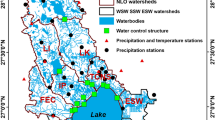Abstract
A simple, rapid, and flexible modelling approach was applied to explore the impacts of climate change on hydrologic inputs and consequent implications for nutrient loading to Lake Mälaren, Sweden using a loading function model (GWLF). The first step in the process was to adapt the model for use in a large and complex Swedish catchment. We focused on the Galten basin with four rivers draining into the western region of Mälaren. The catchment model was calibrated and tested using long-term historical data for river discharge and dissolved nutrients (N, P). Then multiple regional climate model simulation results were downscaled to the local catchment level, and used to simulate possible hydrological and nutrient loading responses to warmer world scenarios. Climate change projections for the rivers of Galten basin show profound changes in the timing of discharge and nutrient delivery due to increased winter precipitation and earlier snow melt. Impacts on total annual discharge and load are minimal, but the alteration in river flow regime and the timing of nutrient delivery for future climate scenarios is strikingly different from historical conditions.




Similar content being viewed by others
References
Andréasson, J., S. Bergström, B. Carlsson, L. P. Graham & G. Lindström, 2004a. Hydrological Change – Climate change impact simulations for Sweden. Ambio 33: 228–234.
Andréasson, J., G. Lindström, G. Grahn & B. Johansson, 2004b. Runoff in Sweden – Mapping of climate change impacts on hydrology. Nordic Hydrological Programme, NHP Report 48: 625–632.
Boesch, D., R. Hecky, C. O’Melia, D. Schindler & S. Seitzinger, 2006. Eutrophication of Swedish Seas. Swedish Environmental Protection Agency (Naturvårdsverket) Report 5509, Stockholm.
Brandt, M. & H. Ejhed, 2002. TRK Transport–Retention–Källfördelning. Belastning på havet. Naturvårdsverket Rapport 5247, Stockholm. (In Swedish.)
Gibson, C. A., J. L. Meyer, N. L. Poff, L. E. Hay & A. Georgakakos, 2005. Flow regime alterations under changing climate in two river basins: Implications for freshwater ecosystems. River Research and Applications 21: 849–864.
Haith, D. A., R. Mandel & R. S. Wu, 1992. GWLF, Generalized Watershed Loading Functions Version 2.0 User’s Manual. December 1992 (corrected and reprinted, January 1996). Department of Agricultural and Biological Engineering, Cornell University, Ithaca, New York.
Haith, D. A. & L. L. Shoemaker, 1987. Generalized watershed loading functions for stream flow nutrients. Water Resources Bulletin 23: 471–478.
Hay, L. E., R. L. Wilby & G. H. Leavesley, 2000. A comparison of delta change and downscaled GCM scenarios for three mountainous basins in the United States. Journal of the American Water Resources Association 36: 387–397.
Houghton, J. T., Y. Ding, D. J. Griggs, M. Noguer, P. J. van der Linden, X. Dai, K. Maskell & C. A. Johnson (eds), 2001. Climate Change 2001: The Scientific Basis. Contribution of Working Group I to the Third Assessment Report of the Intergovernmental Panel on Climate Change. Cambridge University Press, Cambridge.
Johansson, B., 2002. Estimation of areal precipitation for hydrological modelling in Sweden. Doctoral Thesis, Department of Physical Geography, Göteborg University, Göteborg.
Kyllmar, K. & H. Johnsson, 1998. Nutrient losses from arable land within the period 1984–1995. Results from the water quality monitoring programme Typområden på jordbruksmark. Swedish University of Agricultural Sciences, Division of Water Quality Management, Ekohydrologi 44.
Murdoch, P. S., J. S. Baron & T. L. Miller, 2000. Potential effects of climate change on surface-water quality in North America. Journal of the American Water Resources Association 36: 347–366.
Nash, J. E. & I. V. Sutcliffe, 1970. River flow forecasting through conceptual models. Part 1: A discussion of principles. Journal of Hydrology 10: 282–290.
Ogrosky, H. O. & V. Mockus, 1964. Hydrology of agricultural lands. In Chow, V. T. (ed.), Handbook of Applied Hydrology. McGraw-Hill, New York.
Räisänen, J., U. Hansson, A. Ullerstig, R. Döscher, L. P. Graham, C. Jones, M. Meier, P. Samuelsson & U. Willén, 2003. GCM driven simulations of recent and future climate with the Rossby Centre coupled atmosphere Baltic Sea regional climate model RCAO. Reports Meteorology and Climatology 101, SMHI, Norrköping, Sweden.
Samuelsson, P., 2004. RCAO and HadRM3p simulation results with focus on CLIME sites. CLIME Deliverable 5.
Schindler, D. W., 2001. The cumulative effects of climate warming and other human stresses on Canadian freshwaters in the new millennium. Canadian Journal of Fisheries and Aquatic Sciences 58: 18–29.
Schneiderman, E. M., D. C. Pierson, D. G. Lounsbury & M. S. Zion, 2002. Modeling the hydrochemistry of the Cannonsville watershed with GWLF. Journal of the American Water Resources Association 38, 1323–1347.
Schneiderman, E. M., 2006. Modeling Phosphorus with the Generalized Watershed Loading Functions (GWLF) Model. In Radcliffe, D. E. & M. L. Cabrera (eds.), Modeling Phosphorus in the Environment. CRC Press, Boca Raton, FL.
Silgram, M. & O. F. Schoumans (eds), 2004. Modelling approaches: Model parameterisation, calibration and performance assessment methods in the EUROHARP project. EUROHARP report 8-2004. NIVA report SNO 4740-2003, Oslo. 18 pp.
SMHI, 1994. Svenskt Vattenarkiv: Avrinningsområden I Sverige Del 3. Vattendrag till Egentliga Östersjön och Öresund. (In Swedish.).
Willén, E., 2001. Four decades of research on the Swedish large lakes Mälaren, Hjälmaren, Vättern and Vänern: The significance of monitoring and remedial measures for a sustainable society. Ambio 30: 458–466.
Acknowledgements
We thank Pamela Naden and Eleanor Jennings for their contributions to statistical summary methods and programmes, Hampus Markensten for assistance with data acquisition and management and Mark Zion for helpful comments on the manuscript. The European Commission Environment and Sustainable Development Programme provided funding support under contract EVK1-CT-2002-00121 (CLIME).
Author information
Authors and Affiliations
Corresponding author
Additional information
Guest editors: T. Nõges, R. Eckmann, K. Kangur, P. Nõges, A. Reinart, G. Roll, H. Simola & M. Viljanen
European Large Lakes—Ecosystem changes and their ecological and socioeconomic impacts
Rights and permissions
About this article
Cite this article
Moore, K., Pierson, D., Pettersson, K. et al. Effects of warmer world scenarios on hydrologic inputs to Lake Mälaren, Sweden and implications for nutrient loads. Hydrobiologia 599, 191–199 (2008). https://doi.org/10.1007/s10750-007-9197-8
Published:
Issue Date:
DOI: https://doi.org/10.1007/s10750-007-9197-8




